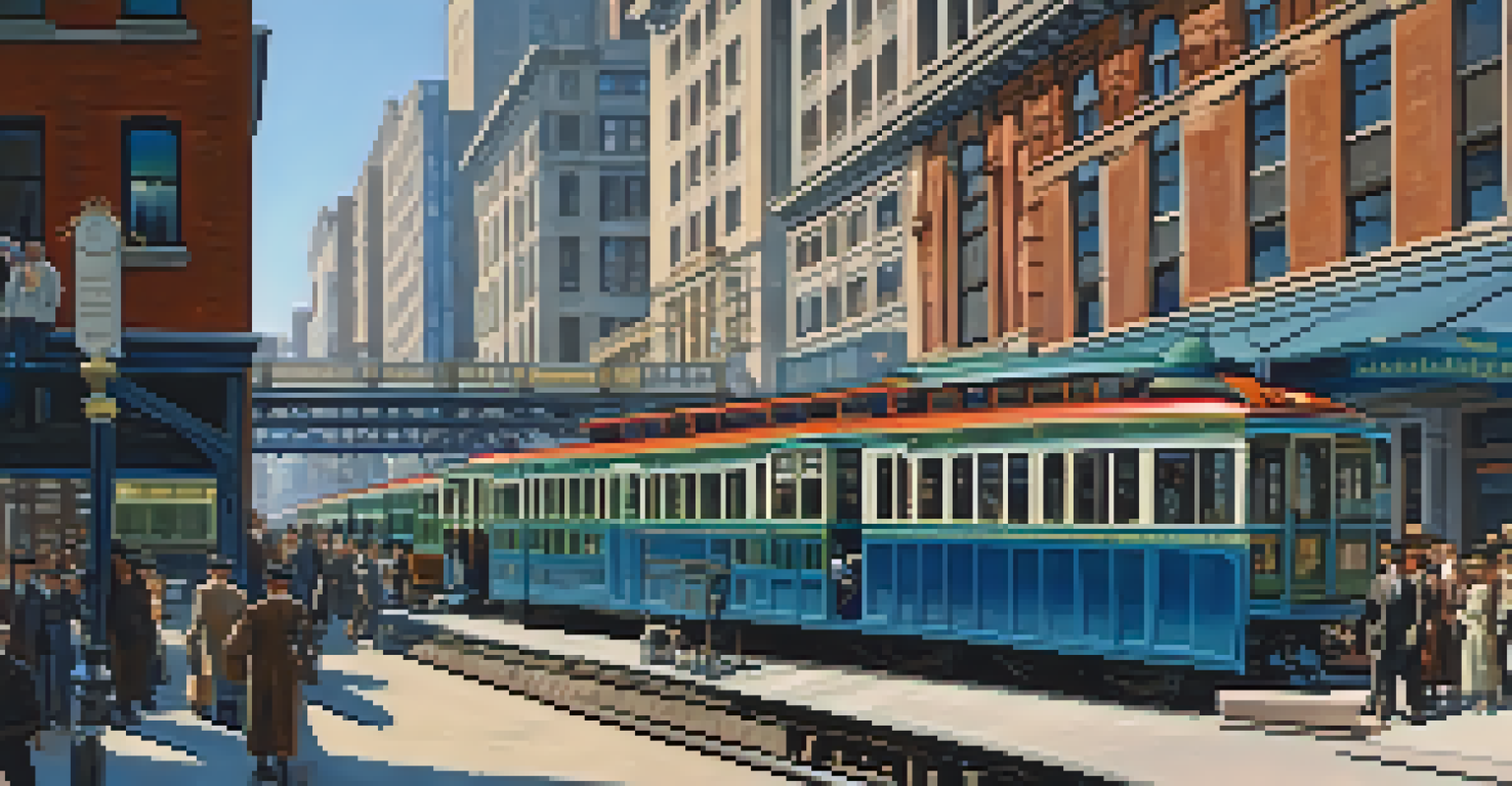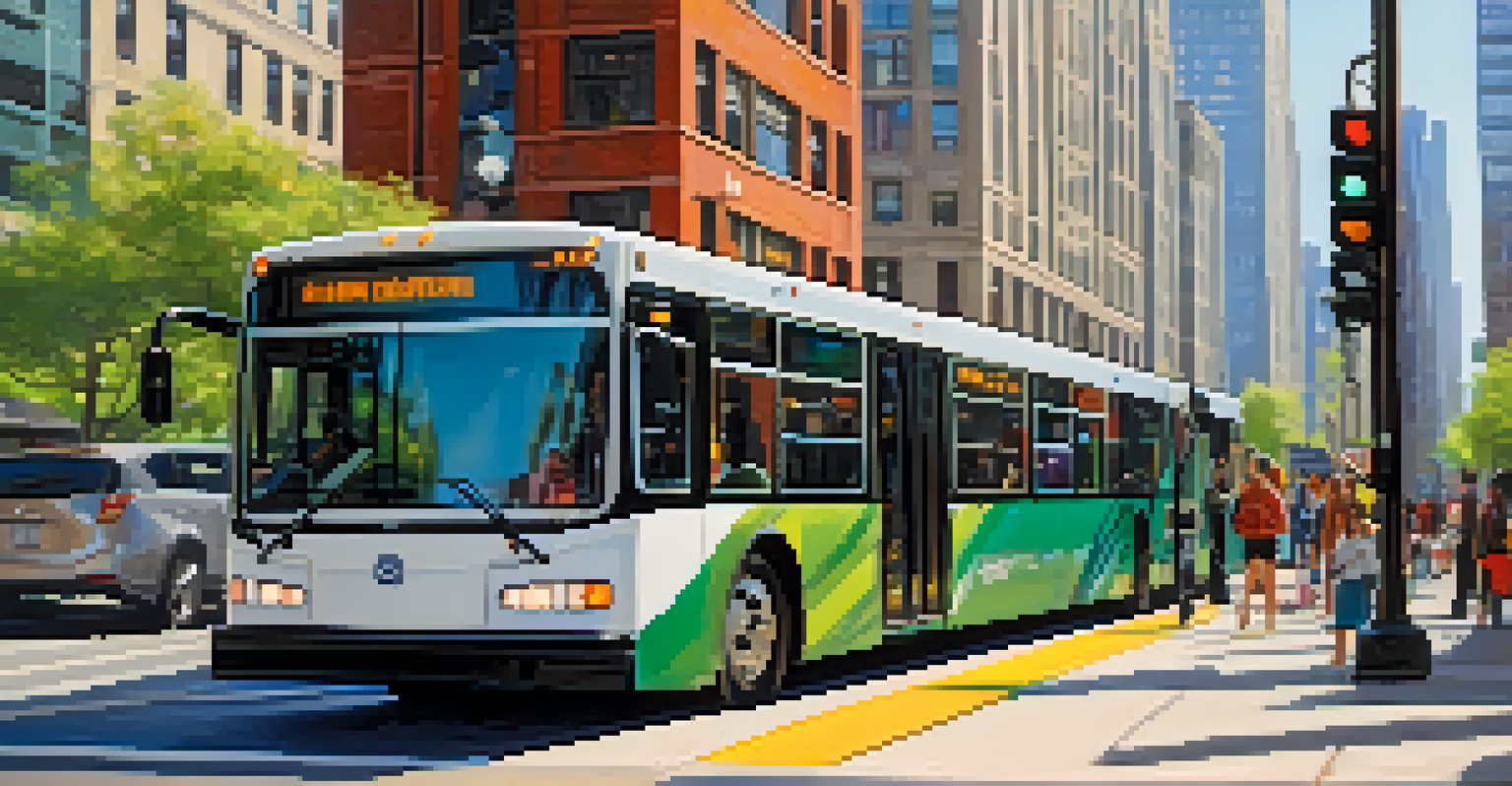The Development of Chicago’s Public Transportation System

The Birth of Public Transportation in Chicago
Chicago's public transportation system began in the mid-19th century with the establishment of horse-drawn streetcars. These early modes of transport were essential for connecting the growing city, making it easier for residents to commute and explore. As the population expanded, the demand for more efficient transportation options became evident, leading to the introduction of steam-powered streetcars in the 1880s.
Public transportation is the backbone of a thriving city.
The transition from horse-drawn to steam-powered streetcars marked a significant milestone in the city's transportation history. This innovation not only increased speed but also expanded the reach of public transit into neighborhoods that were previously inaccessible. It paved the way for further advancements as the city embraced new technologies and urban planning strategies.
By the late 19th century, Chicago was on the brink of a transportation revolution, setting the stage for what would become a comprehensive network of public transit options. The visionaries behind these developments understood that efficient transportation was the backbone of a thriving city. This understanding laid the groundwork for the modern public transportation system we see today.
The Rise of the Elevated Trains
The introduction of elevated trains in the early 20th century transformed Chicago's urban landscape. Known as the 'L,' these trains provided a quick and efficient means of travel above the crowded streets. The first line, which opened in 1892, offered residents a novel way to navigate the city, reducing travel times and increasing accessibility.

Elevated trains quickly gained popularity, prompting the construction of additional lines and stations. This expansion was vital in accommodating the booming population and facilitating economic growth. The L became a symbol of Chicago's innovation, and its distinctive design soon became iconic, representing the city's commitment to modern public transit.
Evolution of Transit in Chicago
Chicago's public transportation evolved from horse-drawn streetcars to modern systems, reflecting the city's growth and technological advancements.
As the elevated train system grew, it not only improved transportation efficiency but also influenced urban development. Neighborhoods around the stations flourished, as businesses and residents were drawn to the convenience of the L. This dynamic relationship between public transit and urban growth became a key feature of Chicago's development.
The Impact of the Great Depression
The Great Depression posed significant challenges for Chicago's public transportation system. As unemployment soared and the economy faltered, ridership declined sharply, straining the resources of transit authorities. Many streetcar lines faced financial difficulties, leading to service cutbacks and fare increases, which further deterred riders.
The future depends on what you do today.
In response to these challenges, city officials sought innovative solutions to sustain the transit system. They implemented fare adjustments and sought federal assistance, recognizing the essential role of public transportation in maintaining city life. The resilience shown during this period helped shape future policies and investments in the transit infrastructure.
Despite the hardships, the Great Depression also spurred some much-needed improvements. The era saw the introduction of more efficient buses and modernized rail cars, which helped revitalize the system for the post-war years. This period of adaptation laid the groundwork for a more robust and reliable public transportation network.
Post-War Expansion and Modernization
After World War II, Chicago's public transportation system underwent significant expansion and modernization. The post-war economic boom led to increased investment in infrastructure, allowing for the renovation of aging facilities and the introduction of new technologies. Buses and trains were revamped to enhance comfort and reliability, making public transit more appealing to riders.
During this time, the Chicago Transit Authority (CTA) was created to oversee the operation of the city's transit system, consolidating various services under one umbrella. This move streamlined operations and improved coordination between different modes of transportation. The CTA's focus on customer service and efficiency helped to attract new riders and retain existing ones.
Impact of Economic Challenges
The Great Depression and late 20th-century economic shifts posed significant challenges, prompting reforms and investments to revitalize transit services.
The post-war era also saw the rise of the automobile, which posed new challenges for public transport. To compete, the CTA introduced innovations like express buses and improved scheduling, ensuring that public transit remained a viable option for commuters. These efforts not only modernized the system but also reinforced its importance in urban mobility.
Challenges of the Late 20th Century
The late 20th century brought a new set of challenges for Chicago's public transportation system. Economic downturns, population shifts, and increased competition from rideshare services impacted ridership and revenue. Many transit authorities struggled to maintain service levels, leading to concerns about reliability and safety.
In response, city officials and transit advocates pushed for reforms and investments aimed at revitalizing the system. Initiatives focused on upgrading infrastructure, enhancing safety measures, and improving service frequency. These efforts aimed to address the declining public perception of transit and showcase its value as a sustainable transportation option.
Despite these challenges, the late 20th century also saw a growing awareness of the importance of public transit in combating congestion and environmental issues. This realization prompted new partnerships and funding opportunities, laying the groundwork for a more resilient and adaptable public transportation system in the years to come.
21st Century Innovations and Sustainability
As we moved into the 21st century, Chicago's public transportation system embraced innovations aimed at enhancing sustainability. The CTA introduced eco-friendly buses and energy-efficient rail cars, reflecting a commitment to reducing the environmental impact of transit. These advancements not only improved service but also attracted environmentally conscious riders.
Technology played a crucial role in transforming the user experience, with the integration of mobile ticketing and real-time tracking apps. These features made it easier for riders to navigate the system, enhancing convenience and accessibility. The CTA's focus on user engagement and feedback helped to foster a sense of community among riders.
Focus on Sustainability and Innovation
In the 21st century, Chicago's transit system embraced sustainability and technology, enhancing user experience and promoting eco-friendly transportation options.
Moreover, the push for sustainability extended beyond vehicles to include initiatives like bike-sharing programs and pedestrian-friendly infrastructure. By creating a seamless connection between different modes of transportation, Chicago aimed to promote a more holistic approach to urban mobility. This commitment to innovation and sustainability is shaping the future of the city's public transportation system.
The Future of Chicago's Public Transportation
Looking ahead, the future of Chicago's public transportation system is filled with opportunities and challenges. As the city continues to grow, transit authorities must adapt to changing demographics and evolving transportation needs. This involves not only maintaining existing infrastructure but also exploring new routes and service models that meet the diverse needs of residents.
Public engagement will be crucial in shaping the future of the transit system, as community input can guide decision-making and prioritize investments. Initiatives aimed at improving accessibility for vulnerable populations will ensure that public transit remains an inclusive option for all. Enhancing safety measures and reliability will also be key to attracting and retaining riders.

Collaboration among city planners, transit authorities, and community organizations will play a vital role in creating a sustainable and efficient public transportation network. As Chicago continues to innovate and embrace new technologies, the public transportation system will be positioned to meet the demands of the future, ensuring that it remains a vital part of the city's identity.